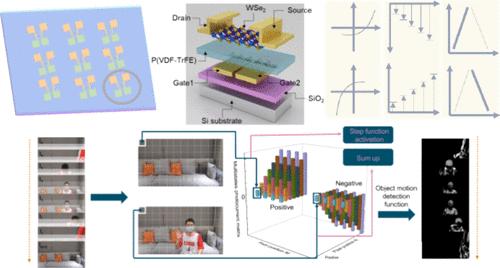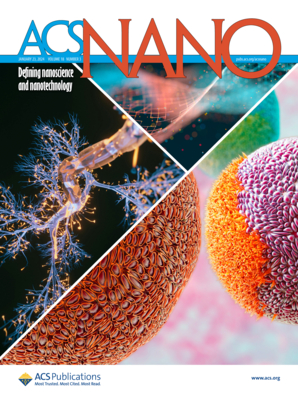铁电调制下的可重构神经形态视觉传感器实现物体运动检测
IF 15.8
1区 材料科学
Q1 CHEMISTRY, MULTIDISCIPLINARY
引用次数: 0
摘要
随着物体运动检测(OMD)需求的增加,需要减少冗余、提高能效和精确编程能力,以确保一致性和准确性。受物体运动敏感神经节细胞的启发,我们提出了一种 OMD 视觉传感器,其器件结构简单,由 WSe2 同质结与铁电共聚物调制而成。在光学模式和中间铁电调制下,视觉传感器可以在零功耗条件下产生具有离散多态的渐进双向光电流。这种设计使可重构器件能够模拟用于更新突触权重的长期电位和抑制,以 6 pA 的均匀步长显示 82 种状态(超过 6 位)。这种 OMD 器件还具有非波动性、可逆性、对称性和超高线性度,拟合 R2 达到 0.999,非线性值达到 0.01/-0.01。因此,视觉传感器只需根据帧间亮度差来感知动态信息,同时消除静态场景中的冗余数据,就能实现运动检测。此外,利用线性结果的神经网络可以识别基本的运动信息,识别准确率高达 96.8%。我们还通过统一的 3 × 3 神经形态视觉传感器阵列展示了可扩展的潜力。我们的工作提供了一个基于可控和高能效铁电可编程性实现运动检测的平台。本文章由计算机程序翻译,如有差异,请以英文原文为准。

Object Motion Detection Enabled by Reconfigurable Neuromorphic Vision Sensor under Ferroelectric Modulation
Increasing the demand for object motion detection (OMD) requires shifts of reducing redundancy, heightened power efficiency, and precise programming capabilities to ensure consistency and accuracy. Drawing inspiration from object motion-sensitive ganglion cells, we propose an OMD vision sensor with a simple device structure of a WSe2 homojunction modulated by a ferroelectric copolymer. Under optical mode and intermediate ferroelectric modulation, the vision sensor can generate progressive and bidirectional photocurrents with discrete multistates under zero power consumption. This design enables reconfigurable devices to emulate long-term potentiation and depression for synaptic weights updating, which exhibit 82 states (more than 6 bits) with a uniform step of 6 pA. Such OMD devices also demonstrate nonvolatility, reversibility, symmetry, and ultrahigh linearity, achieving a fitted R2 of 0.999 and nonlinearity values of 0.01/–0.01. Thus, a vision sensor could implement motion detection by sensing only dynamic information based on the brightness difference between frames, while eliminating redundant data from static scenes. Additionally, the neural network utilizing a linear result can recognize the essential moving information with a high recognition accuracy of 96.8%. We also present the scalable potential via a uniform 3 × 3 neuromorphic vision sensor array. Our work offers a platform to achieve motion detection based on controllable and energy-efficient ferroelectric programmability.
求助全文
通过发布文献求助,成功后即可免费获取论文全文。
去求助
来源期刊

ACS Nano
工程技术-材料科学:综合
CiteScore
26.00
自引率
4.10%
发文量
1627
审稿时长
1.7 months
期刊介绍:
ACS Nano, published monthly, serves as an international forum for comprehensive articles on nanoscience and nanotechnology research at the intersections of chemistry, biology, materials science, physics, and engineering. The journal fosters communication among scientists in these communities, facilitating collaboration, new research opportunities, and advancements through discoveries. ACS Nano covers synthesis, assembly, characterization, theory, and simulation of nanostructures, nanobiotechnology, nanofabrication, methods and tools for nanoscience and nanotechnology, and self- and directed-assembly. Alongside original research articles, it offers thorough reviews, perspectives on cutting-edge research, and discussions envisioning the future of nanoscience and nanotechnology.
 求助内容:
求助内容: 应助结果提醒方式:
应助结果提醒方式:


